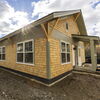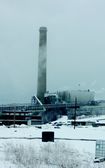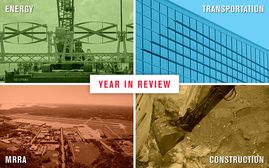Great Northern Paper Co. CEO reflects on 1st year turnaround
 Photo / Garly Langley, Blind Dog Photo Associates
Richard Cyr, CEO of Great Northern Paper Co., sees new products and markets as critical elements of the East Millinocket mill's future.
Photo / Garly Langley, Blind Dog Photo Associates
Richard Cyr, CEO of Great Northern Paper Co., sees new products and markets as critical elements of the East Millinocket mill's future.
Last month, Great Northern Paper Co. CEO Richard Cyr turned over the day-to-day running of the East Millinocket mill to Ned Dwyer, a 26-year paper industry veteran who assumes the title of president.
Besides staying on as Great Northern's CEO, Cyr will continue as CEO of Thermogen Industries, an affiliated Cate Street Capital company that will be opening the first of five planned "bio-coal" manufacturing plants in Millinocket later this year.
Mainebiz recently interviewed Cyr about his efforts to create two successful and sustainable businesses in the Millinocket region. The following is an edited transcript.
Mainebiz: What is the current employment level at the Great Northern paper mill in East Millinocket? Are both the mill's No. 5 and No. 6 papermaking machines still running?
We have 257 workers employed at our East Millinocket mill. Both machines are running, although the second machine, which we've renamed "Penobscot," only runs when we need it. When we have a large chunk of business and we've already got the other papermaking machine filled, which we've renamed "Katahdin," we can put it on Penobscot and run that machine to complete the job.
We'll make sure to refer to those machines in the future by their new names.
Thank you (laughing). That would be very nice. The workers will get a chuckle out of it. I'm trying to rewire 30 years of programming and calling them No. 5 and No. 6. I've run a campaign of labeling the machines, putting the names out front, changing any reference to No. 5 and No. 6 to "Katahdin" and "Penobscot" — or "Kat" and "Pen" as they've become known among the workers.
Your business backgroundchiefly has been in marketing. How were you able to take that experience and apply it to running a paper mill?
Since I didn't have any paper mill experience, I asked "Why?" a lot. I was absolutely not bashful about asking why we did things the way we did.
When I started out, I was asking 'Why?' because I had no idea what they were doing. But in time — and it came pretty quickly — I was mostly asking "Why?" to get people thinking about what they were doing. Not being a "paper guy" was a huge advantage, because my questions forced people to look at things differently and to consider other practices from other industries.
If you step into a situation like a mill that's been shut down numerous times and has been owned by several parties that had a very rough long road of contracting over the last 20 years, you have a morale issue. I spent a considerable amount of time paying attention to how the place looked. I put a lot of effort and money into making things clean, getting things clean, getting things painted, just trying to re-instill pride back into the workers and convince them we were there for the long run and that we were making investments, and making a difference.
Of course that translates into a better product, because with pride comes taking particular pride in the practices that make a better product come out of this paper mill.
You've mentioned "right sizing" the business model and focusing strategically on what's going to work at the East Millinocket paper mill. Could you explain how that works
In my opinion, paper mills tend to produce more paper than they should. This is a commoditized product and that tends to put out more supply than there is a demand. That drives prices downward and it just spirals downward. That's a bad cycle that's been going on for a very long period of time within the industry.
In my opinion, paper mills tend to produce more paper than they should. This is a commoditized product and that tends to put out more supply than there is a demand. That drives prices downward and it just spirals downward. That's a bad cycle that's been going on for a very long period of time within the industry.
... We can make 250,000 or 300,000 tons of paper, but it doesn't matter that we can. The question is: Should we? The answer is: No, we should not. There is not enough demand to support that. Our mill can become sustainable and going down the right road is if we focus on new products, and new markets and being aggressive, and take the blinders off. Stop forcing it into the box we built 20 years ago, or 30 years ago, or 50 years ago, and think outside of it.?
Obviously in 2012 you benefited greatly from the wild popularity of '50 Shades of Grey,' published by Random House. Did that job put you on Random House's radar screen, and will it lead to more work in the future?
Random House already was a customer of ours. We had done books like the "Girl with the Dragon Tattoo" — that Tattoo series is published by Random House as well, so they're well aware of what we can do. We hadn't done a lot with them, but we had done a fair amount. Now, what the "50 Shades of Grey" title did for us is not so much that it brought us to the attention of Random House: It brought us to the attention of everyone else. I'm a marketing guy, so that was very, very nice.
Could you give our readers a sense of how you see 2013 shaping up for Great Northern?
Well, in 2012 we started working very hard to try to get away from being so dependent on standard newsprint. Standard newsprint, as you know, is a commoditized product and its market is obviously shrinking, for a lot of reasons that have nothing to do with the paper industry but rather have to do with how we receive information.
So that's an effort that started in 2012 and will continue on in 2013 and gain additional momentum.
Every day we move forward, as far as I'm concerned, is a lot easier than the days we've got behind us. We get stronger and stronger every day that goes by.
In addition to being the CEO of Great Northern, you're CEO of Thermogen Industries. How far along is the construction on the first Thermogen plant?
We had said we were going to get all the site work preparation done before the winter set in, and we did. Come spring we can start to construct what we'll need in order to put in all the equipment that will be needed. The time frame for opening is still probably the third quarter, and the fourth quarter for shipping the product.
How is your role at Great Northern changing, now that you've stepped down as president?
Now that I'm back to the CEO role, I no longer have to immerse myself in matters of the day-to-day operations of the mill. I get to focus on questions like: Where is the paper industry going? Where can I take this mill so that it's doing well for the next 20 to 30 years? What new markets can I push into? What products are coming down the pipeline? What products are out there that our machine can produce?
Creating a sustainable future isn't just about products and markets: It's also about an aging work force. We need to bring people in, get them trained, because over time — over the next two, three, five years — you're going to see a number people retiring who are working at the mill today . The average age is 57, and it goes right into workers who are 62 and 63, who are just a couple of years away from retirement. Some of the guys are retiring this year.
So that's where your interests dovetail with the governor's interests in work force training and encouraging students to think of going into the trades, and not just college, as a viable future?
Absolutely. We started beating that drum with the governor's office a year ago, because the way I saw it: If we didn't start bringing in and training the younger generation to work at the mill, we'd be out of business in five years.
You now have a "paper guy" who's going to be working closely with you: Ned Dwyer, who recently was named president of Great Northern. Tell us about him.
Ned's a great addition. Ned knows the paper industry, he knows the mill environment, he's been around it a long time. What's great about it is that I can go off and focus on the larger strategic issues and help him bring in more money into the mill and make sure the mill is going to be sustainable through product and market development. And he can make sure the mill is producing the kind of tons it needs to, by paying attention to the details.
I'm more of a bigger picture guy. He's able to do the stuff that now needs to be done there.













Comments